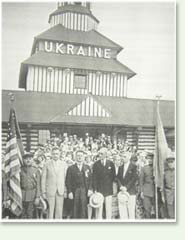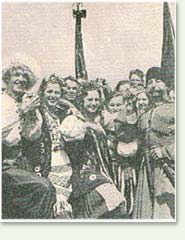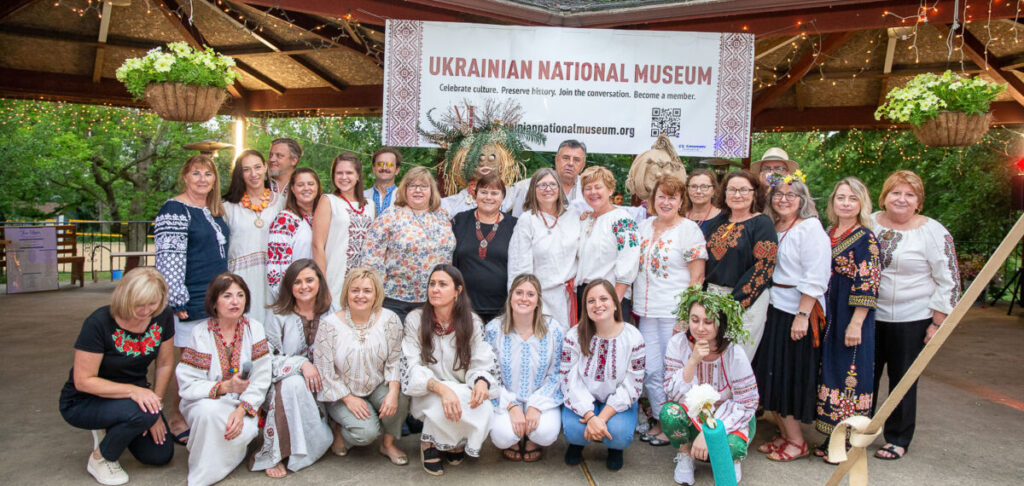
Celebration to mark the opening of the Ukrainian Pavilion in Chicago during the World’s Fair, 1933. The Ukrainian community in the Chicagoland area is scattered widely, with the core neighborhood in the city located in what is known as Chicago’s “Ukrainian Village.” This central area has been the focus of Ukrainian life since the turn of the 20th century, and continues to function as its hub with three major Ukrainian churches, two Ukrainian banks, a Ukrainian grammar school, the Ukrainian National Museum, a Ukrainian Cultural Center, two Ukrainian youth organizations, and many Ukrainian restaurants, stores and businesses. There have been four mass immigrations from Ukraine to the United States. The first immigrants arrived during the period 1870-1914. Most of these early immigrants from Ukraine were poor, illiterate peasants seeking a better life in America. Many small Ukrainian enclaves developed throughout Chicago, including the area bounded by Division, Racine, Orleans and Roosevelt; another in the Burnside area and another in what has become known as the Ukrainian Village. A small pocket of immigrants colonized Packingtown on the South Side of Chicago. In 1903 they erected a church that stood in the shadows of the large slaughterhouses that characterized the area. The First Greek Catholic Church of St. Mary’s of Chicago featured a three barred cross on the steeple. Beneath the cross was a crescent, symbolic of the victory of Christianity over Islam. St. Mary’s soon became an integral part of Rusyn culture. 
Scene from the groundbreaking for the Ukrainian Pavilion in Chicago. The second, interwar, wave of immigration occurred between 1920-1939 following Ukraine’s declaration at the end of World War I as an independent nation. In contrast to the first wave of immigrants, Ukrainians arriving in Chicago at this time were semi-skilled, literate workers who had decided to come to the United States to escape the political and economic pressures of the newly independent Ukraine. Ukrainians played an important role in Chicago’s Centennial Exposition in 1933. The Ukrainian Pavilion at the Exposition housed a restaurant and exhibit halls demonstrating folk art and history. By the 1930s, there were five Ukrainian parishes dotting Chicago’s neighborhoods, including the lovely Byzantine-Slavonic style of St. Nicholas Cathedral. Built between November 1913 and January 1915, St. Nicholas is in the heart of the Ukrainian neighborhood south of Wicker Park and along Chicago Avenue, fondly referred to by locals as the Ukrainian Village. This neighborhood, northwest of the Loop, was first settled by Polish and Slovak immigrants, but with the rise of Ukrainian nationalism and the influx of political refugees during World War I, it assumed a Ukrainian cultural identity which lingers to this day. The third, post World War II, wave of immigration occurred between approximately 1948-1955. This wave of immigration brought with it a highly skilled, professional Ukrainian population who entered the United States following the passage of the Displaced Persons Act of 1948. Forced to leave Ukraine on the eve of the Soviet onslaught, they were committed to Ukraine’s freedom crusade. Following WWII, thousands of political refugees from war-torn Eastern Europe found their way to America, including professionals, physicians, lawyers, writers and intellectuals who had stood in opposition to the Stalinist regime. The population surge of the 1950s energized Chicago’s Ukrainian Village and spurred construction of new parishes and the founding of new organizations. Among the organizations and institutions founded in the early 1950s was Selfreliance Federal Credit Union, as a continuation of the cooperative traditions prevalent in Ukraine during the 1900s. The credit union was founded by the Selfreliance Association of American-Ukrainians, which also spawned a number of professional groups such as the Ukrainian Medical Association of North America (UMANA). In 1969 St. Nicholas parish switched from the traditional Julian calendar to the Gregorian, which sparked an angry protest among traditionalists in the congregation. A dissenting group of parishioners broke away and started their own church-Sts. Volodymyr and Olha Parish. During the first five years of its existence the parish conducted its service in St. Volodymyr Ukrainian Orthodox Church. Their new church was dedicated by Patriarch Joseph Slipyi. The new parish can be credited with revitalizing Ukrainian Community life and stabilizing the Village at a time when many Ukrainians were moving to the suburbs. The area has since become gentrified. Ukrainian pride is reflected in the many Ukrainian cultural institutions in the Village. The Ukrainian Institute of Modern Art celebrates the work of Ukraine’s contemporary artists worldwide. The Ukrainian National Museum has become an important repository of ethnic and folk memorabilia and also acts as an archive for the Ukrainian Community in Chicago. Sts. Volodymyr and Olha Parish constructed a Cultural Center, which is home to the Ukrainian Congress Committee of America, the publication of the Encyclopedia of the Ukrainian Diaspora, the Ukrainian Dance Group “Hromovytsia” and other groups. The two major Ukrainian youth groups also have their headquarters on Chicago Avenue in the Village. The Selfreliance Cooperative Association was the former owner of the Co-op Food Store on Chicago Avenue, in the Village which is now the Ukrainian Village Grocery Store. The Association also owns a resort on Round Lake in northern Illinois, purchased in the 1950s with shares purchased by the immigrants so that they would have a place where their children could spend their summers away from the heat of the city. The fourth, and most recent, wave of immigration from Ukraine to the United States occurred in the 1990s following the dissolution of the Soviet Union and subsequent opening of Ukraine’s borders to the west. While the largest influx of Ukrainians to Chicago occurred shortly after 1990, immigration to Chicago from Ukraine continues to the present time. As each subsequent wave before them, these new arrivals have made their mark on Chicago as well. Many Ukrainian shops were founded along Chicago and Western Avenue over the years. Over time, some have closed and others have taken their place. Most prominent today are those established by the “fourth wave” which has proven to be quite entrepreneurial. It is easy to spot the various Ukrainian-owned businesses; just look for the posters advertising various Ukrainian cultural events. Ukrainian Chicago extends far beyond the Ukrainian Village. As Ukrainians became more well-to-do they moved out into the outlying neighborhoods and suburbs. Larger groups settled in various geographic areas, establishing churches and community centers. The largest of these are on the northwest side of Chicago in Palatine, Bloomingdale, Palos Heights, Berwyn and in northern Indiana. For more information on Chicago’s Ukrainian Village see:
|

